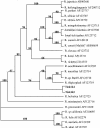Characterization of spotted fever group rickettsiae in flea and tick specimens from northern Peru
- PMID: 15528680
- PMCID: PMC525230
- DOI: 10.1128/JCM.42.11.4961-4967.2004
Characterization of spotted fever group rickettsiae in flea and tick specimens from northern Peru
Abstract
Evidence of spotted fever group (SFG) rickettsiae was obtained from flea pools and individual ticks collected at three sites in northwestern Peru within the focus of an outbreak of febrile disease in humans attributed, in part, to SFG rickettsia infections. Molecular identification of the etiologic agents from these samples was determined after partial sequencing of the 17-kDa common antigen gene (htrA) as well as pairwise nucleotide sequence homology with one or more of the following genes: gltA, ompA, and ompB. Amplification and sequencing of portions of the htrA and ompA genes in pooled samples (2 of 59) taken from fleas identified the pathogen Rickettsia felis. Four tick samples yielded molecular evidence of SFG rickettsiae. Fragments of the ompA (540-bp) and ompB (2,484-bp) genes were amplified from a single Amblyomma maculatum tick (tick 124) and an Ixodes boliviensis tick (tick 163). The phylogenetic relationships between the rickettsiae in these samples and other rickettsiae were determined after comparison of their ompB sequences by the neighbor-joining method. The dendrograms generated showed that the isolates exhibited close homology (97%) to R. aeschlimannii and R. rhipicephali. Significant bootstrap values supported clustering adjacent to this nodule of the SFG rickettsiae. While the agents identified in the flea and tick samples have not been linked to human cases in the area, these results demonstrate for the first time that at least two SFG rickettsia agents were circulating in northern Peru at the time of the outbreak. Furthermore, molecular analysis of sequences derived from the two separate species of hard ticks identified a possibly novel member of the SFG rickettsiae.
Figures



References
-
- Adams, J. R., E. T. Schmidtmann, and A. F. Azad. 1990. Infection of colonized cat fleas, Ctenocephalides felis (Bouche), with a rickettsia-like microorganism. Am. J. Trop. Med. Hyg. 43:400-409. - PubMed
-
- Beati, L., M. Meskini, B. Thiers, and D. Raoult. 1997. Rickettsia aeschlimannii sp. nov., a new spotted fever group rickettsia associated with Hyalomma marginatum ticks. Int. J. Syst. Bacteriol. 47:548-554. - PubMed
Publication types
MeSH terms
Substances
Associated data
- Actions
- Actions
- Actions
LinkOut - more resources
Full Text Sources

